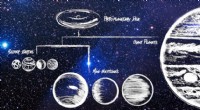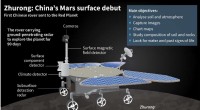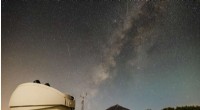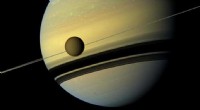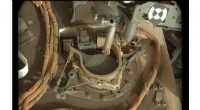
Wetenschap
Vraag en antwoord:voor het vinden van aardachtige exoplaneten zijn nieuwe ruimtetelescopen nodig
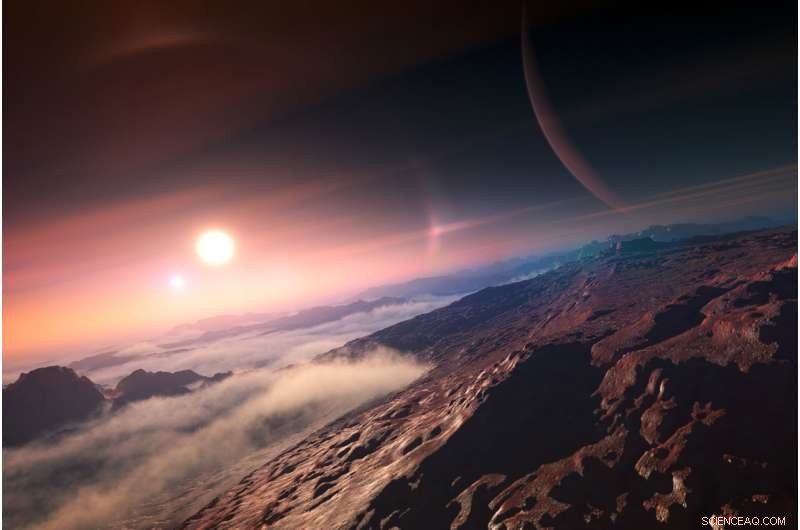
Een artistieke weergave van een exoplaneet gezien vanaf zijn maan. Stanford-astrofysicus Bruce Macintosh zegt dat het vinden van verre zonnestelsels om bewoonbare planeten te zoeken belangrijk is voor ons perspectief op onze plaats in het universum. Krediet:IAU / L. Calçada
Een nieuw type ruimtetelescoop kan helpen bij het vinden van leven op andere planeten of het ontdekken van andere zonnestelsels zoals het onze, volgens een rapport dat onlangs is uitgevoerd door de National Academies of Sciences, Techniek &Geneeskunde.
Stanford-astrofysicus Bruce Macintosh, die lid was van de verslagcommissie, zei dat de voorgestelde telescoop direct aardachtige exoplaneten zou afbeelden die rond sterren draaien die vergelijkbaar zijn met onze zon, en zou kunnen samenwerken met observatoria op de grond om chemische gegevens over exoplaneetatmosferen te verzamelen.
Stanford Report sprak met Macintosh over hoe de voorgestelde telescoop zou werken, hoe het is om verre zonnestelsels te vinden en wat we kunnen leren door te zoeken naar bewoonbare planeten.
Waarom heeft het Congres om dit rapport gevraagd?
Dit rapport belichtte twee belangrijke vragen die de toekomst van exoplaneetonderzoek zullen bepalen. De grote is, zijn er nog andere levendragende planeten? De andere grote vraag is, hoe ontstaan en evolueren planetaire systemen, en is ons zonnestelsel zeldzaam of een gemeenschappelijk onderdeel van dat proces?
We weten nu dat planeten rond andere sterren vrij gewoon zijn, maar we begrijpen niet helemaal hoe die andere zonnestelsels ontstaan. In feite, we begrijpen nu minder hoe planeten ontstaan dan hoe zwarte gaten of neutronensterren ontstaan.
Hoe worden exoplaneten nu ontdekt en bestudeerd?
Er zijn verschillende manieren om exoplaneten te bestuderen. De dominante zijn wat we indirecte technieken noemen, waar je de planeet niet echt ziet. De meest voorkomende van deze indirecte methoden is de transittechniek. Dat is waar de planeet, zoals het draait, passeert voor de ster, het een beetje blokkeren zoals gezien vanaf de aarde en ervoor zorgen dat het een paar uur lang een klein beetje dimt.
Maar er zijn beperkingen aan de transittechniek. Voor nu, het laat je alleen de atmosferische details voor reuzenplaneten bestuderen, planeten die meerdere malen groter zijn dan de aarde, omdat ze grote sferen hebben die veel licht absorberen. Ook, de kans dat het werkt gaat veel omhoog als de planeet dicht bij de ster staat en als de ster klein is, dus het is een geweldige manier om planeten dicht bij kleine sterren te bestuderen. Dat is interessant, maar het werkt niet voor aardachtige planeten rond grote sterren en het werkt helemaal niet voor planeten die ver van hun sterren verwijderd zijn.
De andere benadering, wat onze groep hier doet, is directe beeldvorming. Daar zie je eigenlijk een planeet los van een ster. Het is werkelijk, heel moeilijk omdat planeten miljoenen en miljarden keren zwakker zijn dan hun sterren. Direct, directe beeldvorming werkt alleen voor planeten die groter zijn dan Jupiter en ver van hun ster verwijderd zijn.
Momenteel, alleen grondtelescopen zijn in staat om exoplaneten rechtstreeks in beeld te brengen. De telescopen die we in de ruimte hebben, zijn daar nu niet echt voor ontworpen. Een duidelijke boodschap van dit rapport is dat als we planeten zoals de aarde zullen zien draaien rond sterren zoals onze zon, we hebben een ruimtetelescoop nodig die hiervoor is ontworpen.
Hoe zouden deze telescopen werken?
Er worden twee hoofdbenaderingen overwogen. De eerste is wat een "coronagraaf"-telescoop wordt genoemd, die spiegels en maskers in de telescoop zelf gebruikt om een kunstmatige zonsverduistering te creëren die het licht van de sterren blokkeert, zodat de kleine, zwakke planeet ernaast is detecteerbaar.
De andere benadering, een sterrenschaduw genoemd, staat voor een andere manier om een kunstmatige zonsverduistering te creëren. Om te begrijpen hoe dit werkt, stel je voor dat je een vogel dicht bij de zon wilt zien vliegen. Wat doe jij? Je houdt je hand omhoog en blokkeert de zon. Een sterrenscherm werkt volgens hetzelfde principe, behalve dat het ruimte is, dus je hebt een gigantische ruimtehand van ongeveer 50 meter breed en ongeveer 30, 000 to 50, 000 miles away from your telescope.
This giant hand, or starshade, flies lined up between your telescope and the star so that the star's light is blocked and the planet can peep out around its edge. Every time you want to look at a new star, you move the pair of them around to point in a different direction.
When they're operating, they have to hold their alignment to about a meter or so relative to each other. That's hard, but it's engineering hard. The physics is really easy. We can show that the shape of the starshade is crucial for making the shadow dark enough so that it really, really blocks the star. And some of us at Stanford are working on a microsatellite to test the concept.
What would an exoplanet that has been imaged by one of these telescopes look like?
We're not making pictures like the Apollo 8 picture, where you see the continents and so on. Direct, and for the foreseeable future, exoplanets imaged this way will still look like a dot – but it's a dot that we can use to measure a planet's chemistry and understand what it's made of.
What can you learn about an exoplanet through direct imaging that you can't with indirect methods?
Because you've blocked out the star, you're actually seeing reflected light from the planet itself, not just inferring it's there. And if you see light from objects, you can do what we call spectroscopy, where you look for the light signatures of particular atoms or molecules that are present in the planet's atmosphere.
The hope is you'd see the signature of oxygen because we think the only way you can get a lot of oxygen in a planet together with other substances like methane is if something changes the chemistry of that planet and kicks it out of equilibrium.
The reason we have oxygen on Earth is life. If you kill everything on Earth, then the oxygen will go away in a few million years. It's not impossible other planets could make oxygen on their own, but by far the best explanation we know of is the presence of life, so that's really what you're looking for is that signature of oxygen.
When could the first of these planet-imaging telescopes launch?
That's the less good news. We already have the next big space telescope, de James Webb-ruimtetelescoop, which is currently scheduled to launch in 2021.
The next project beyond that is a telescope called WFIRST. The proposed planet imager would have to start after WFIRST. That probably translates into a launch in something like 2035 or even a little bit later.
anno 2015, your group discovered a Jupiter-like exoplanet using the Gemini South Telescope in Chile, and before that, you helped discover a four-planet system. What does it feel like to discover a new world?
It's pretty awesome. We've had Kepler's laws for 400 years, but when we discovered the HR8799 planets, we were witnessing Kepler's laws in action – in a system with four giant planets that's light-years away. It's just spectacularly awesome.
Why is studying exoplanets important?
That's a legitimate question to ask. This is not knowledge that leads to concrete results on Earth, and we're not going to visit these planets for hundreds of years at least, but it's important to our perspective on the universe.
Er was eens, humans were the center of the universe, and then astronomers proved that we were not the center of the universe. That shifted, fundamenteel, our view of how important we are, and how the universe doesn't really revolve around us, but we're still the only life we know of in the universe.
If we discover that life exists elsewhere in the universe, that's a similarly epochal shift in our perception of how we fit in it. Or it's possible that life is really rare, and the exact circumstances that made Earth such a beautiful planet haven't happened in all these other thousands of solar systems, and we're the only one that got it right.
That's almost as important to know. If we're the only habitable planet within 1, 000 light-years, we really should do a good job of looking after this one habitable planet because it's even more precious and special than we knew.
We could build the equipment that's needed to answer that fundamental question, but it's going to take us 20 years to build it, so we better get started now.
 Algemene descriptor zorgt voor vooruitgang in kleurstofchemie
Algemene descriptor zorgt voor vooruitgang in kleurstofchemie De kosten van ethanol verlagen, andere biobrandstoffen en benzine
De kosten van ethanol verlagen, andere biobrandstoffen en benzine Wetenschappers lossen structuur van eiwit met verstandelijke beperking op
Wetenschappers lossen structuur van eiwit met verstandelijke beperking op De impact van moleculaire rotatie op een eigenaardig isotoopeffect op waterstofbruggen in water
De impact van moleculaire rotatie op een eigenaardig isotoopeffect op waterstofbruggen in water Ribeye-etende varkens demonstreren eiwitkwaliteit voor mensen
Ribeye-etende varkens demonstreren eiwitkwaliteit voor mensen
 Hoe kunnen we de fotodegradatie van plastic versnellen?
Hoe kunnen we de fotodegradatie van plastic versnellen?  De vroegste menselijke invloed op geologische processen vond plaats 11, 500 jaar geleden (update)
De vroegste menselijke invloed op geologische processen vond plaats 11, 500 jaar geleden (update) Australië spant zich in om duizenden te bereiken die zijn gestrand door bosbranden
Australië spant zich in om duizenden te bereiken die zijn gestrand door bosbranden Welke soorten wilde katten leven in New York?
Welke soorten wilde katten leven in New York?  Malachiet is de prachtige groene edelsteen Cleopatra Wore
Malachiet is de prachtige groene edelsteen Cleopatra Wore
Hoofdlijnen
- Prozac in oceaanwater een mogelijke bedreiging voor het zeeleven, studie vondsten
- El Nino in de Stille Oceaan heeft invloed op dolfijnen in West-Australië
- Wit vlees of donker vlees? Big data serveren om het Thanksgiving-diner te ontcijferen
- Zilte zwembadbacteriën kunnen opruimen en opstarten
- Negen verdwaalde olifanten geëlektrocuteerd in Botswana
- De microbiologische kunst van het maken van een betere worst
- Insecten kunnen mensen leren omgaan met tegenslag
- Antropologen beschrijven derde orang-oetansoort
- Hoe SARS werkt
 Werkloosheidsuitkeringen bereikten slechts een kwart van de ontslagen werknemers
Werkloosheidsuitkeringen bereikten slechts een kwart van de ontslagen werknemers De fysica lezen die zich in gegevens verstopt
De fysica lezen die zich in gegevens verstopt Google bevestigt dat het een betaalpas wil vrijgeven
Google bevestigt dat het een betaalpas wil vrijgeven Nieuwe nanotechnologie die de strijd tegen colorectale kanker en melanoom verbetert
Nieuwe nanotechnologie die de strijd tegen colorectale kanker en melanoom verbetert AX J1949.8+2534 is een superreus snelle X-ray transiënt, waarnemingen bevestigen
AX J1949.8+2534 is een superreus snelle X-ray transiënt, waarnemingen bevestigen Gaan roodharigen uitsterven?
Gaan roodharigen uitsterven?  Planetaire botsingen kunnen de interne druk in planeten verlagen
Planetaire botsingen kunnen de interne druk in planeten verlagen Dissipatieve koppeling produceren in hybride kwantumsystemen
Dissipatieve koppeling produceren in hybride kwantumsystemen
- Elektronica
- Biologie
- Zonsverduistering
- Wiskunde
- French | Italian | Spanish | Portuguese | Swedish | German | Dutch | Danish | Norway |

-
Wetenschap © https://nl.scienceaq.com

